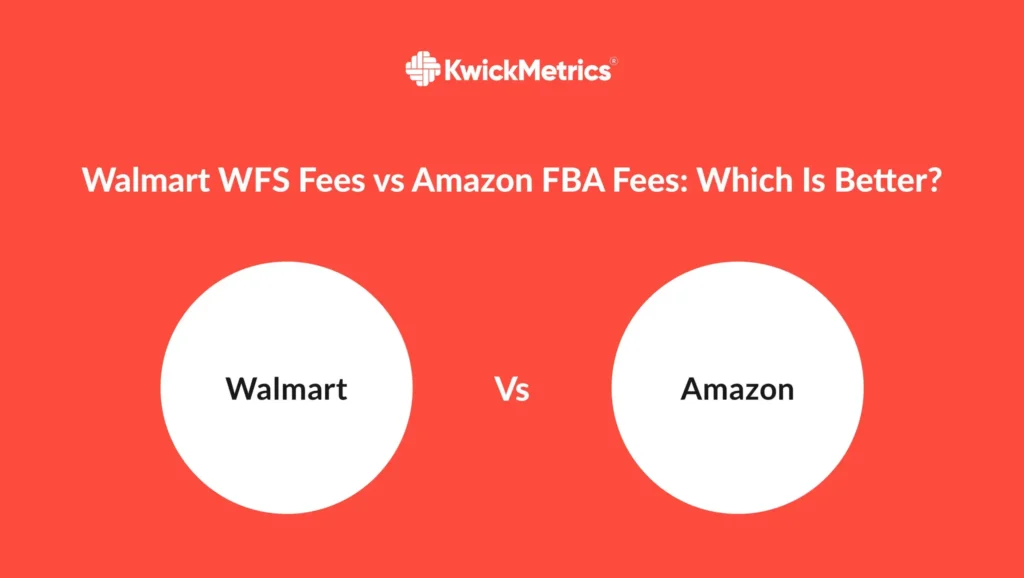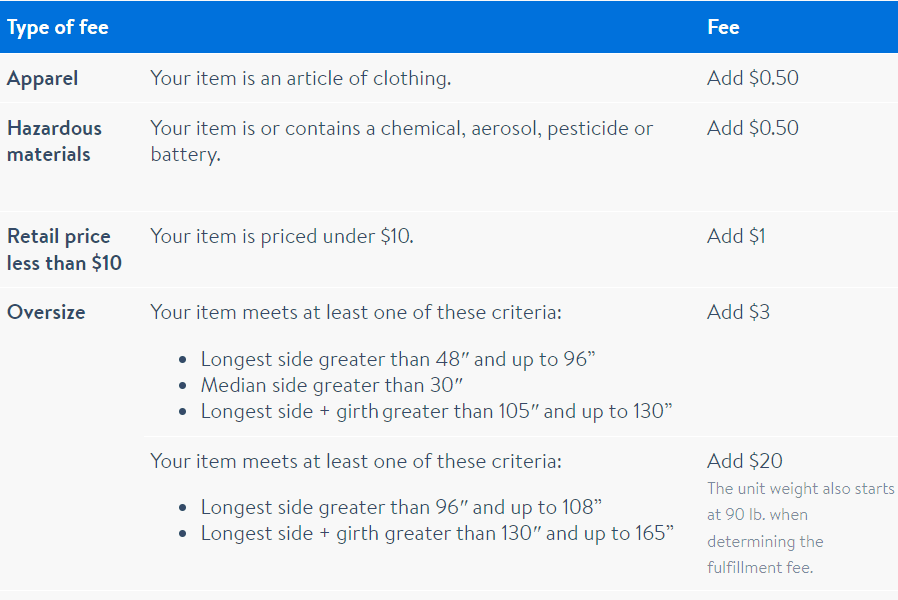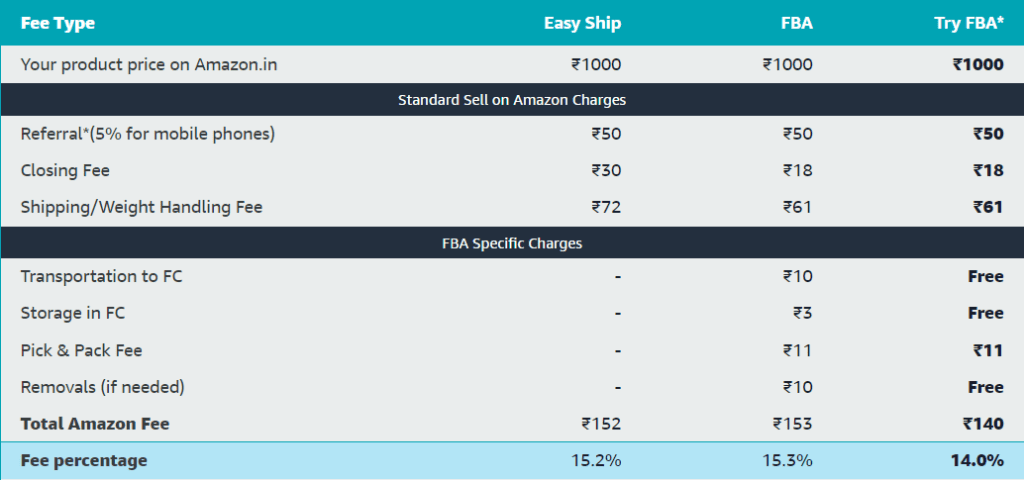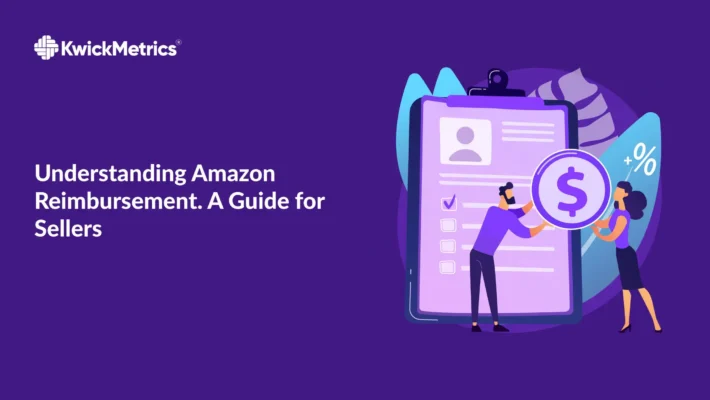Walmart WFS Fees vs Amazon FBA Fees: Which Is Better?

Table of Contents
- Overview of Walmart WFS and Amazon FBA
- Importance of Fulfillment Services for E-Commerce Sellers
- Fulfillment Centers
- Fulfillment Services
- KwickMetrics - The Business Intelligence and Analytics Tool
- Eligibility and Requirements
- Performance Metrics
- Seller Control and Branding
- Customer Reach: Walmart WFS vs Amazon FBA
- FAQs related to Walmart WFS vs Amazon FBA
- Conclusion
- Discover more about KwickMetrics by using our demo account
In the bustling realm of e-commerce, the heartbeat of success resonates through the choices made in fulfillment services. Two titans, Walmart Fulfillment Services (Walmart WFS) and Fulfillment by Amazon (Amazon FBA) stand at the forefront, offering distinct avenues for sellers to navigate. In this article, we set the stage by providing a panoramic view of Walmart WFS vs Amazon FBA, recognizing their pivotal roles in shaping the destiny of e-commerce sellers.
Overview of Walmart WFS and Amazon FBA
What is Walmart WFS
Walmart WFS is an abbreviation for Walmart Fulfilment Services, a complex web of logistics meant to support sellers by streamlining the fulfillment process. Walmart WFS attracts sellers into a world of rapid order processing, packaging, and shipping with located fulfillment centers and a dedication to seamless operations.
What is Amazon FBA
Amazon FBA emerges as a beacon for sellers seeking the highest level of fulfillment prowess in the e-commerce industry. Amazon’s (FBA) Fulfilment by Amazon service includes a global network of fulfillment centers, promoting itself as a one-stop shop for order fulfillment, shipping, and customer service, all seamlessly managed by the e-commerce giant.
Importance of Fulfillment Services for E-Commerce Sellers
In the ever-changing landscape of e-commerce, the importance of selecting the correct fulfillment provider cannot be simple. E-commerce businesses must strike a careful balance between delivering customer expectations for quick, accurate, and trustworthy order fulfillment. Fulfillment services such as Walmart WFS and Amazon FBA help merchants with logistical headaches and contribute directly to consumers.
The importance of efficient Walmart fulfillment services and Amazon fulfillment services can be distilled into several key aspects:
1. Customer Experience: Timely and accurate order fulfillment contributes significantly to a positive customer experience. Customers today demand swift shipping and hassle-free returns, making fulfillment services a critical element in retaining and attracting buyers.
2. Scalability: As e-commerce businesses grow, the scalability of fulfillment operations becomes paramount. Choosing a service that can seamlessly adapt to varying order volumes ensures that sellers can navigate growth without compromising on operational efficiency.
3. Marketplace Visibility: Fulfilment services are intricately linked with marketplace visibility. Using platforms’ logistics power, such as Walmart WFS or Amazon FBA, can improve product awareness, perhaps leading to improved sales and brand recognition.
4. Time and Resource Optimization: By outsourcing fulfillment, sellers can put their resources and time into important business activities like product development, marketing, and customer engagement. This optimization is vital for overall corporate growth.
Key Takeaway:
Fulfillment services like Walmart WFS and Amazon FBA are crucial for e-commerce sellers. They enhance customer experience through timely and accurate order fulfillment, provide scalability for growing businesses, boost marketplace visibility, and allow sellers to optimize their time and resources for other vital business activities. Thus, they play a significant role in the success and growth of e-commerce businesses.
Fulfillment Centers
Walmart WFS
1. Number and Locations of Fulfillment Centers
Walmart WFS has a strategically placed network of fulfillment centers that ensures comprehensive coverage throughout major regions. While the actual number may vary, Walmart has constantly increased its fulfillment center presence in order to improve order fulfillment efficiency. These distribution centers are carefully located to promote timely and cost-effective shipment while fulfilling the needs of a broadened customer base.
2. Warehouse Size and Capacity
Walmart WFS’s warehouse infrastructure is built to accommodate a wide range of products, from small items to large products. The warehouse size and capacity vary by location, allowing for the storage and effective management of a wide range of products. The vast design of Walmart’s fulfillment centers reflects the company’s dedication to scalability, allowing merchants to smoothly integrate their products into the supply chain.
Amazon FBA
1. Number and Locations of Fulfillment Centers
Amazon FBA controls a vast and dynamic network of fulfillment centers throughout the world, showing unparalleled global reach. The exact number of fulfillment centers may change as Amazon continues to expand, but as of the most recent update, there were multiple centers strategically distributed to meet the needs of local and international markets.
2. Warehouse Size and Capacity
Amazon’s fulfillment centers are characterized by their vast warehouse spaces equipped with advanced automation technology. The size and capacity of these facilities are tailored to accommodate the diverse needs of sellers, ranging from small-scale businesses to large enterprises. Amazon FBA’s commitment to innovation ensures that its fulfillment centers are equipped to handle a wide array of products, from small electronics to oversized items.
Key Takeaway:
Walmart WFS and Amazon FBA both operate extensive networks of fulfillment centers strategically located for efficient order fulfillment. These centers, varying in size and capacity, are designed to handle a wide range of products. Walmart’s centers ensure comprehensive regional coverage, while Amazon’s centers demonstrate unparalleled global reach. Both services are committed to scalability and innovation, accommodating the diverse needs of sellers and contributing to the smooth integration of products into the supply chain.
Fulfillment Services
Walmart WFS
1. Order Processing and Packing:
Streamlined and efficient system for accurate order preparation.
Minimizes errors and delays, ensuring a positive customer experience.
2. Shipping Options:
Provides diverse shipping options to match customer preferences.
Flexible choices, including standard, expedited, and tailored services.
3. Returns Handling:
Robust processes for efficient returns handling.
Emphasis on hassle-free returns, contributing to overall customer satisfaction.
Amazon FBA
1. Order Processing and Packing:
High standard with advanced automation for swift and meticulous order fulfillment.
Reduces fulfillment time and enhances accuracy.
2. Shipping Options:
Offers a spectrum of shipping choices, including standard, expedited, and same-day delivery (region-dependent).
Leverages Amazon’s vast logistics network for reliable and competitive shipping.
3. Returns Handling:
Streamlined returns process for both sellers and customers.
Enhances customer trust by ensuring an efficient returns experience.
Fee Structure Walmart WFS vs Amazon FBA
| Fee Structure | Walmart WFS | Amazon FBA |
|---|---|---|
| Storage Fees | Based on the volume of the product being stored and the length of time | Based on the daily average volume of the space your inventory occupies in fulfillment centers |
| Order Fulfillment Fees | Incurred per order for picking, packing, shipping | The comprehensive fee for fulfillment processes varies according to product size and weight |
| Long-Term Storage Fees | Incurred in peak seasons (Oct to Dec) | Incurred for extended storage periods, encouraging inventory management |
| Removal Fees | Applied when sellers choose to remove items from fulfillment centers, managing inventory turnover | Applied when sellers choose to remove items from fulfillment centers, managing inventory turnover |
KwickMetrics - The Business Intelligence and Analytics Tool
Explore 14-day free trial! No credit card required, cancel at any time.
Additional Costs Walmart WFS vs Amazon FBA
| Cost Type | Walmart WFS | Amazon FBA |
|---|---|---|
| Subscription Fees (if Applicable) | May incur subscription fees based on agreement | Amazon seller account fees vary based on the chosen plan |
| Packaging Costs | Sellers cover expenses related to packaging | N/A (included in the overall fulfillment process) |
| Removal and Disposal Fees | Incurred when opting to remove of inventory | Incurred when opting to remove or dispose of inventory |
Walmart Fee Structure




Amazon Fee Structure

Eligibility and Requirements
Walmart WFS
1. Application Process:
Sellers interested in using Walmart WFS must go through an application process.
The application typically involves providing necessary business information and details about the products to be sold.
2. Eligibility Criteria:
Walmart WFS has specific eligibility criteria that sellers must meet to qualify for the service.
Criteria may include being an existing Walmart seller with a positive sales history, product quality standards, products shipped from within the United States, a weight limit of 30 pounds, the ability to ship to Walmart fulfillment center locations in the United States, and compliance with Walmart’s seller policies.
Amazon FBA
1. Application Process:
Sellers looking to leverage Amazon FBA must also undergo an application process.
The application involves creating an Amazon seller account and opting into the FBA program.
2. Eligibility Criteria:
Amazon FBA has certain eligibility criteria that sellers must meet to use the service.
Amazon FBA eligibility is a three-step process. If you can successfully create an account to sell on Amazon and follow the product limits and inventory requirements you are qualified for FBA
Key Takeaway:
Both Walmart WFS and Amazon FBA have application processes and specific eligibility criteria that sellers must navigate. Understanding and meeting these requirements are crucial steps for the sellers.
Performance Metrics
Walmart WFS
1. On-time shipping: This score measures the seller’s ability to fill orders accurately and quickly. It is critical for keeping a positive relationship with both the platform and its end customers. Walmart expects that its Marketplace sellers will maintain an on-time delivery record of 95% or higher. You are responsible for delivering packages to clients if you do not use Walmart Fulfilment Services (WFS).
2. Order Accuracy: This metric is related to ensuring product quality and providing excellent customer service. It’s about meeting customer expectations: when people buy your products online, they expect the quick delivery of a quality product. They also want their queries answered and to know when they can expect their purchase to be delivered. If you fail to match these demands, your business will be affected.
Amazon FBA
1. Order Defect Rate (ODR): ODR is a measure of the percentage of orders that have been returned or canceled due to defects in the product or service. Divide the number of orders returned or canceled due to defects by the total number of orders placed during a certain period to calculate the Amazon Order Defect Rate. A high ODR shows that customers frequently return orders, which states bad customer service and reflects the seller’s work.
2. Late Shipment Rate: Orders are considered late if they are shipped three or more days after the scheduled ship date. Amazon requires suppliers to keep their dispatch rate under 4%. A Late Dispatch Rate of more than 4% may result in a seller account being suspended or terminated.
Key Takeaway:
These metrics are essential for maintaining a good relationship with the platforms and the end customers. They also offer insight into the health of your business. Please note that the specifics of these metrics and how they are calculated can vary between platforms and over time, so it's always a good idea to check the latest guidelines from each platform.
Seller Control and Branding
Walmart WFS
1. Branding Options:
Walmart WFS allows suppliers to brand and customize their products.
Sellers can use branding options to establish and strengthen their brand in the Walmart marketplace.
2. Customer Communication:
Sellers who use Walmart WFS have a certain degree of control over client communication.
Through personalized communication channels, sellers can engage with customers and create relationships.
Amazon FBA
1. Branding Options:
Amazon FBA offers branding options to sellers, allowing them to showcase their brand on product pages and packaging.
Sellers can utilize branded content and design elements to enhance their visibility and create a distinct brand presence.
2. Customer Communication:
Sellers using Amazon FBA have limited control over customer communication.
Amazon manages customer interactions, including inquiries and feedback automation, to ensure a consistent and reliable customer experience.
Key Takeaway:
While both Walmart WFS and Amazon FBA provide branding options to sellers, the level of control over customer communication varies. Walmart WFS grants sellers more autonomy in managing customer interactions, while Amazon FBA maintains a standardized approach to ensure a seamless and reliable customer experience across the platform. Sellers should consider these aspects when choosing a fulfillment service that aligns with their brand strategy.
Customer Reach: Walmart WFS vs Amazon FBA
Walmart WFS
1. Walmart’s Customer Base:
Sellers leveraging Walmart WFS gain access to Walmart’s extensive customer base in the United States.
Walmart, as a major retail player, provides sellers with the opportunity to tap into a large and diverse pool of potential customers.
2. Marketplace Visibility:
Using Walmart WFS increases sellers’ market visibility.
Products fulfilled through Walmart WFS benefit from increased exposure within the Walmart online marketplace.
Amazon FBA
1. Amazon’s Customer Base:
Amazon FBA sellers tap into Amazon’s vast and global customer base.
Amazon’s reputation and widespread reach provide sellers with the potential to connect with millions of customers worldwide.
2. Marketplace Visibility:
Products fulfilled through Amazon FBA enjoy unparalleled marketplace visibility.
The prominence of Amazon in the e-commerce landscape ensures high visibility for FBA products, increasing the likelihood of sales.
Key Takeaway:
Both Walmart WFS and Amazon FBA offer sellers the opportunity to reach a substantial customer base and enhance their marketplace visibility. While Walmart WFS provides access to Walmart's customer ecosystem, Amazon FBA leverages Amazon's global reach, providing sellers with expansive visibility within the highly trafficked Amazon marketplace. Sellers should consider the specific dynamics of each platform to maximize their customer reach and overall business growth.
FAQs related to Walmart WFS vs Amazon FBA
Q. What are the primary fee differences between Walmart WFS and Amazon FBA?
A: Walmart WFS charges storage, order fulfillment, and potential subscription fees. Amazon FBA includes storage, fulfillment, long-term storage, removal, and optional labeling service fees.
Q. How do Walmart WFS and Amazon FBA differ in terms of customer communication and branding?
A: Walmart WFS grants sellers more control over customer communication and offers branding options. Amazon FBA manages customer communication centrally for consistency and provides branding options for product pages and packaging.
Q. How does the customer reach differ between Walmart WFS and Amazon FBA?
A: Walmart WFS provides access to Walmart’s customer base and boosts visibility within the Walmart platform. Amazon FBA taps into Amazon’s global customer base, ensuring extensive visibility within the highly frequented Amazon marketplace.
Conclusion
The decision between Walmart WFS and Amazon FBA is critical in the world of e-commerce fulfillment. Walmart WFS excels in streamlined processes with efficient order processing, while Amazon FBA boasts a global logistics network and diverse shipping options. Fee structures vary, with Walmart WFS charging storage and fulfillment fees, and Amazon FBA encompassing storage, fulfillment, and additional fees. Seller control diverges, as Walmart WFS offers more autonomy in branding and customer communication, whereas Amazon FBA maintains a standardized approach. Both platforms provide access to significant customer bases, with Walmart WFS enhancing visibility within the Walmart platform and Amazon FBA leveraging Amazon’s global reach. The decision should be in line with the nature of the seller’s product, target audience, and overall business goals, ensuring a strategic fit for a successful e-commerce experience.
Choose Wisely, Happy Selling!


